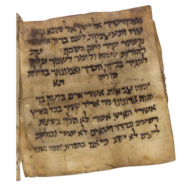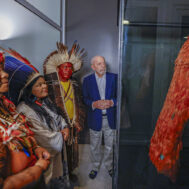The U.S. is poised to lock in a 5-year extension of an already 30 year long blockade on imports of ancient and ethnographic art from Mali. Since 1993, the U.S. has restricted imports from the sub-Saharan African nation. In past centuries, Mali held a number of African kingdoms, including the Ghana, Mali and Songhai empires from the 12th to 17th century. The most famous artifacts originating in Mali are its Djenne terracotta figurines, wooden and ceramic masks and the extraordinary manuscripts spanning the last thousand years stored in community and family libraries, mosques and Sufi shrines in the ancient trading capital of Timbuktu.
Mali, a nation in chaos, welcomes Russian surrogates to an ongoing conflict.

Hunter in Dogon region, Mali. Flintlock rifle. Photo J. Drevet, 10 November 2010, CCA-SA 3.0 Unported license.
The region known today as Mali was colonized as French Sudan in 1892; its present-day national borders were defined under French rule. Much of northern Mali is the Sahel, Saharan desert. The ancient trading city and religious center of Timbuktu is located in central Mali. The main cities and majority of Mali’s 20 million population are in the far less arid south and the wet plains of the Niger Delta.
Mali’s peoples are ethnically, linguistically, and culturally varied. The Tuareg and Moors dominate the Saharan regions but comprise only about 10% of the population. Much of its rural economy remains based upon subsistence farming and pastoralism, especially in the northern area populated by agriculturalists and Tuareg and Moor herders. Educational levels are low and up to half the population is illiterate.
Active civil warfare between Mali’s military government, centered in the south, and Islamic extremists and local powerholders in the northern areas, has left Mali in a perpetual state of conflict and humanitarian crisis for more than a decade.

Fulani family from Mali, photo by Ferdinand Reus from Arnhem, Holland, 12 June 2008, CCA-SA 2.0 Generic license.
Like many other European African colonies, Mali gained full independence only after WWII. After an initial alliance with Senegal, Mali became the Republic of Mali in 1960, joined the ‘non-aligned’ nations that supported the Soviet Union at the U.N., but rebuilt ties with France in 1970. The Republic’s first President Modibo Keïta, installed in 1960, established a socialist dictatorship with Pan-Africanist leanings. A 1968 coup installed a military junta led by Lt. Moussa Traoré. A constitution was approved in 1974 but the military kept actual hold on the government. A more broadly based government emerged after elections in 2002.
A simmering rebellion by Tuareg factions in 2012 exploded when extremist militants linked to al Qaeda and the Islamic State turned on the Tuareg and captured large sections of the north.
One of the greatest cultural losses came in 2012 when Ansar ed Dine extremists directed their forces against the ancient, shrine-filled town of Timbuktu destroying ancient buildings and threatening Timbuktu’s famed libraries before being driven out by French and Malian forces.

Le premier Ministre du Mali, Boubou Cissé et le président Ibrahim Boubakar Keita, June 2019, Kassim Traoré (VOA), public domain
French Armed Forces soldiers arrived in large numbers to combat Ansar ed Dine and together with the Malian military succeeded in recapturing much of the north, enabling elections late in 2013. A brief quiescent period ended as conflicts between Dogon and Bambara farming peoples with Fulani pastoralists escalated and ethnically based militias fought over land and resources.
Periodic ceasefires and elections enabled the country to hold together in principle for some time, but in 2019 the fighting and the sporadic but increasingly brutal massacres of civilians increased. A coup d’etat led by Colonel Assimi Goïta followed popular uprisings against the elected Ibrahim Boubacar Keita government in September 2020. The military created a transitional government and promised elections and a transition to civilian rule in 18 months.
At the same time, France and its European partners and United Nation peacekeepers decided that they were unable to cope with the political instability and deteriorating security in the north and unwilling to keep thousands of troops in Mali after nine frustrating years.

Dioncounda Traoré and his staff in Mali, January 23, 2020. (VOA / Kassim Traoré) From left to right: Diango Cissoko (former minister), Dioncounda Traoré and Abass Dembélé (colonel-major, 23 January 2020, Kassim Traoré (VOA), public domain.
The latest request for a blockade on Malian art and artifacts comes at a time of particular political uncertainty for the country. Mali’s military junta announced in January 2022 that elections promised for February 2022 would be delayed for up to five years. ECOWAS, the Economic Community of West African States, had responded with strict sanctions. The EU had urged a more moderate response, not wishing to isolate Mali or collapse its already teetering economy. Mali’s government, meanwhile, was encouraging demonstrators in its capital, Bamako, to take to the streets to protest ECOWAS sanctions.
In 2021 and now in 2022, Mali is bent on expanding its military and political connections with Moscow. As the French left the country, Mali’s military was being replenished with hundreds of soldiers from the ostensibly private military group Wagner.[1] Military experts say that the Wagner Group is a thin cover for Russian mercenaries now being used to expand Moscow’s influence in 28 mostly unstable nations.[2] Malian officials claim that the newly arrived soldiers are Russian “army instructors,” and not from Wagner. Russian President Vladimir Putin has said the opposite, that these are “commercial activities,” and that the Russian government is not involved. The U.S. has sanctioned the Wagner Group, which has been repeatedly accused of war crimes including “torture, rape, and indiscriminate murder of civilians.”[3] The Wagner Group’s role is characterized by U.S. analysts as providing security to threatened governments and hunting down insurgents, while extracting highly favorable mining contracts in exchange for its services.
Requirements under U.S. law to renew a cultural property agreement with Mali.

US Ambassador to Mali Paul Folmsbee, right, and Mali’s Minister of Culture N’Diaye Ramatoulaye Diallo officially launched the website and opened the exhibition from the archives of five professional photographers from the Mali namely Malick SIDIBE, Adama Kouyate, Tidiani Sitou, Abdourahmane Sakaly and Mamadou Cisse, Bamako, Mali, May 16, 2017. (VOA/Kassim Troaré)
This was the situation in Mali when in January 2022, the Cultural Property Advisory Committee (CPAC) met in open session to hear testimony the renewal of a 30-year-old agreement blocking importation of ancient and ethnographic objects into the U.S.[4] The agreement, a Memorandum of Understanding or MOU, would continue to block recent imports or objects from Mali into the U.S. unless they have a valid permit for export from Mali or a provable provenance of being outside of Mali for at least ten years. The law which governs CPAC , the Cultural Property Implementation Act, requires that:
- All restricted cultural patrimony must be threatened by pillage.
- The requesting country must have taken measures to protect its cultural patrimony.
- Other nations with a significant import trade in the designated objects have established similar restrictions; import restrictions would be of substantial benefit in deterring a serious situation of pillage, and other, less drastic remedies are not available.
- The application of the import restrictions is consistent with the general interest of the international community in the interchange of cultural property.
Whatever it has shared privately with the State Department, under whose Cultural Heritage Center the CPAC committee operates, Mali’s government has not made any public statement showing that these conditions are met. Nor have Mali’s series of governments demonstrated that they are willing to take substantive action inside the country to preserve Malian heritage or a build a cultural infrastructure.

Timbuktu Cultural sign, UNESCO, 15 February 2005, GLAM-Wiki partnership.
A decade ago, in 2011, when Mali was seeking a fifth renewal of U.S. cultural property import restrictions, Samuel Sidibé, the director of the National Museum of Mali, spoke at a meeting commemorating the 40th anniversary of 1970 UNESCO Convention on Cultural Property. He explained that looting and illicit excavations had peaked in Mali in the 1970s and 1980 when wooden masks from the region became popular on the international market. He said that “unscrupulous people” then began falsifying them, and as a result collector interest moved to harder-to-fake ceramic masks, which then became subject to looting.[5]
‘What has Mali been doing to protect its cultural heritage?’ Sidibé posed the question himself. In 1985, he said, Mali adopted strict legislation that objects from archaeological sites cannot be traded commercially or exported for sale. ‘All our archeological objects found in Europe are in violation of the law in Mali,” he said.[6]
Sidibé told the group that besides passing this law, Mali had made an agreement with the U.S. and was working on one with Switzerland for the return of its heritage. Malian cultural workers had examined severely looted sites to better understand the context and spoken to communities throughout Mali. He said,
“Communities have traditionally had the concept that sites are income, and we have been educating them that archaeological sites are culture.”[7]
In fact, nine grants have been made by the U.S. State Department for various cultural programs in Mali, but its governments have never supported a comprehensive approach for the protection of its heritage.
The Timbuktu libraries story.
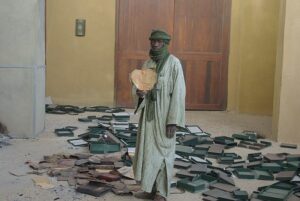
Man holding a burnt manuscript, IHERI-AB, Timbuktu, 31 January 2013, UNESCOGLAM-Wiki partnership.
One facet of Mali’s cultural infrastructure has received serious attention, and although this key institution, the Ahmed Baba Institute of Higher Learning and Islamic Research in Timbuktu has done major work in safeguarding an irreplaceable part of Mali’s cultural heritage, it has done so through the combined efforts of Timbuktu’s residents and the international donors that provided funding and technical support.
When the world-famous shrines of Timbuktu were threatened with complete destruction in 2012 by besieging extremist rebels, dedicated individuals organized the secret transportation of thousands of ancient manuscripts to the Malian capital, Bamako. Dr. Abdul Kader Haïdara, who collected many of the manuscripts now at the Ahmed Baba Institute of Higher Learning and Islamic Research (CEDERAB) at Timbuktu, and is executive director of the nonprofit SAVAMA-DCI and Dr. Abdoulkadri Maïga, at the time the director of the Ahmed Baba Institute, were both instrumental in preserving the Timbuktu libraries. An estimated 370,000 manuscripts, many counted as single pages, were secretly transported by individuals and families by taxis, trucks, carts or boats under the noses of the insurgents. Local residents bravely hid the manuscripts held by families tasked with caring for ancient private libraries.

Manuscripts of the Ahmed Baba Centre, Timbuktu, 6 June 2013, UNESCO, GLAM-Wiki partnership.
UNESCO had organized the Ahmed Baba Institute of Higher Learning and Islamic Research (CEDERAB) in Timbuktu in 1967 as a Malian government entity, to hold and preserve ancient manuscripts; it was funded initially by Kuwait and completely rebuilt with help from South Africa in 2009. Before the takeover of Timbuktu by Ansar ed Dine insurgents in 2012, the Ahmed Baba center had gathered thousands of manuscripts from sources in Timbuktu and elsewhere in Mali. Some 26,000 manuscripts from the Ahmed Baba center were eventually preserved in Bamako, despite the insurgents having quartered themselves in the center after taking Timbuktu and burning books they found there.
Other African nations and international interests came together to provide funding for the restoration and safeguarding of the manuscripts – and hundreds of press reports kept the world focused on Timbuktu’s losses. UNESCO developed a multi-million dollar plan to save damaged mosques and mausoleums in 2014. UNESCO continues to sponsor restoration of manuscripts damaged in the Ansar ed Dine attack.[8]
SAVAMA-DCI, headed by Dr. Abdul Kader Haïdara, spearheaded the work of documentation and restoration of the manuscripts still stored in Bamako. CEDERAB’s current director, Dr Mohamed Diagayété directs the restoration work at the Ahmed Baba Institute in Timbuktu.
Continuing unrest and a recent restitution.

Long range patrol with the MINUSMA contingent of Bangladesh based in Gao, northern Mali.
Aside from the manuscript restoration projects, funded from outside of Mali, and regardless of the desire of Mali’s limited cultural sector to do more, its succession of governments has done little more on its own initiative than to sign heritage agreements in which other countries undertake to restitute objects. When the U.S. agreement with Mali was renewed in 2016 for the sixth time, Mali was again in a state of civil and political unrest, and the CPAC committee and Department of State again gave Mali time to reorganize before prioritizing cultural protections. Five years have passed since then, and despite additional grants from the U.S. Ambassador’s Fund for ‘training’, Mali has not provided information showing that it has undertaken self-help measures as required under the Cultural Property Implementation Act.
Restitutions have been initiated by museums gifted objects acquired prior to the first 1993 MOU with Mali. In 2012, a pair of 13-15th c. terracotta figures from Djenne, Figure of a Ewe and Kneeling Figure, were bequeathed to the Boston Museum of Fine Arts by collector William Teel. The Museum of Fine Arts took the initiative and contacted Mali in 2012 and asked Mali to research the pieces to determine their status. They were believed to have been illegally excavated sometime in the 1980s. It has taken ten years to get an agreement to return these significant pieces back to Mali; the museum announced completion of an agreement on February 9, 2022.[9]
Testimony submitted on Mali’s renewal request.
The Committee for Cultural Policy[10] and Global Heritage Alliance[11] jointly submitted testimony on a proposed five-year extension of the thirty-year-old MOU. CCP and GHA’s testimony discussed Mali’s current political instability, its past failure to fund local protection for archaeology and artifacts or to loan U.S. museums Malian objects so the U.S. public could be educated about and appreciate Malian heritage. They argued that Mali’s failure to meet U.S. self-help and other requirements for thirty years did not justify another five-year extension of a clearly unworkable agreement under the Cultural Property Implementation Act.
Since 1993, the US government has sought to protect the cultural heritage of the Republic of Mali by making agreements with the governments in power to block imports of Malian art.

Headless figure, Jenne-jeno, Mali, 900-1400 AD, terracotta – National Museum of Natural History, United States, photo Daderot, 27 March 2015, CC0 1.0 Universal Public Domain Dedication
From 1993 to 2007, the U.S. placed import restrictions on archaeological objects from the region of the Niger River Valley of Mali and the Bandiagara Escarpment.[12] In 2007, the U.S. expanded import restrictions to cover archaeological artifacts from the Paleolithic Era to approximately 1750 CE for 5 years.[13] These restrictions on all Malian artifacts up to 1750 CE were extended in 2012.[14] Then in September 2017 the U.S. signed a bilateral agreement continuing all the prior restrictions on archaeological materials ceramic, leather, metal, stone, glass, textiles, and wood from the Paleolithic Era to approximately 1750 CE, with the addition of manuscripts dating between the twelfth and twentieth centuries in paper, and extended the import restrictions to September 19, 2022.[15]
For decades past, the Malian government has not documented its activities to protect Malian artifacts, identified how funds are spent to secure archaeological sites, or provided evidence that it takes seriously its obligation to preserve heritage or share it with the U.S. public through loans to museums. Although Mali had received more monetary grants for heritage development from the U.S. State Department than any other country, there has been no public report of the results of these grants.
As in the case of all prior renewal requests, no information on how Mali has met the statutory requirements for import restrictions under the Cultural Property Implementation Act has been made public either by Mali or the U.S. State Department.
The only information release on the most recent request, expanding import restrictions to 35 years and including objects up to the early 20th century was the following single sentence:
“The Government of the Republic of Mali requested that the agreement be amended to include additional categories of archaeological and ethnological materials from the Paleolithic period to A.D 1920.”

Products of local artisans, Djenne, Mali, photo by BluesyPete, 26 November 2007, CCA-SA 3.0 Unported license.
Under US law, bilateral agreements are supposed to be made only when they meet all of the statutory criteria under the CPIA: there must be a current situation of looting of the materials for which embargo is requested, the countries must be working internally to protect their cultural patrimony, import restrictions must have a “substantial benefit,” no remedy less drastic than an embargo will help to stop looting, and finally, an embargo must be “in the general interest of the international community in the interchange of cultural property.”
It is up to the requesting country to establish that it has met the criteria under U.S. law for a bilateral agreement. This is even more the case in a renewal request, when the U.S. needs to know if the requesting country has performed – or even attempted to perform actions it has undertaken to do under a prior agreement.
When the content of the source country requests is not made public, there is no way to judge whether, why or how past U.S. import restrictions have had any positive effect at all. The public is left entirely in the dark on the reasons for expansion of the embargo to objects up to the 20th century. This information is not available from the Government of Mali either.
Requests for information from the Department of State that are necessary for a meaningful public response are routinely denied. The response is always, “You may apply under the Freedom of Information Act.” However, over the last decade, the Department of State responses to requests under FOIA, when and if they are granted, are so heavily redacted that they provide no substantive information. The responses to public inquiries are effectively to ‘pound sand.’[16] This deliberate obfuscation prevents the public from making comments useful to CPAC’s deliberations.
MOUs under the Cultural Property Implementation Act must meet specific criteria, by law. Mali’s does not.
(1) All restricted cultural patrimony must be threatened by pillage. Mali has failed to demonstrate that the unidentified objects in the proposed Designated List are in jeopardy of pillage.
The State Department has not made public any documentation of contemporary looting in Mali that would justify a potentially blanket import embargo for objects from the Paleolithic to 1920.
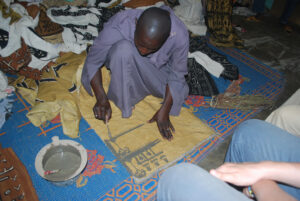
Textile painter in Djenne, Mali. photo by BluesyPete, 26 November 2007, CCA-SA 3.0 Unported license.
If such information was provided, it could encourage public support for more comprehensive MOUs. Nor has the Department of State informed the public of the actions taken by Mali to preserve cultural artifacts in archaeological sites or even in local cultural institutions, nor set forth the steps taken by the Mali to ensure that the US public has at least minimal access to its art through traveling exhibitions or exchanges with US museums. CPAC cannot blame concerned citizens for objecting to renewing or expanding an agreement when it deliberately withholds the information that would allow them to support a MOU in good conscience.
(2) The requesting country must have taken measures to protect its cultural patrimony. Mali has not taken sufficient measures to meet the self-help requirement.
The State Department’s United States Ambassadors’ Fund for Cultural Heritage has provided nine grants since 2020 to Mali. The most recent is a project to document the textile traditions of the Dogon, Fulani and others in central Mali and to assist crafts persons to revitalize traditional textile production. In the two decades since the inception of the Ambassadors Fund, Mali has received nine such grants, “including the preservation of Islamic manuscripts; the preservation of the 14th century mosque of Kankan Moussa in Gao; the documentation of endangered musical traditions; and an inventory of archaeological sites.”

Songho, The Palaver Hut, Dogon Country, Mali, photo by BluesyPete, 26 November 2007, CCA-SA 3.0 Unported license.
It would be of interest to know the status of these nine grants, to what degree the projects are still operating, and if completed, what are the results. For example, in January 2020, the U.S. Embassy and Mali’s Ministry of Culture’s National Directorate of Cultural Patrimony sponsored a week-long technical training for 35 Malian archeologists and technicians to create the first ever “Inventory of Mali’s Archeological Heritage.” The grant provided $116,000 for training and to document major archaeological sites in the regions of Kayes, Koulikoro, Sikasso, Ségou, and Bamako in Mali.[17] A relevant question would be, what has been done in the last two years and has the Government of Mali continued the project on its own initiative?
Among many unanswered questions are: How much is the Government of Mali spending to preserve and restore historic sites? Are there paid guards at major archaeological sites? What is the budget for the National Museum and other museums in Mali?
A policy on cultural heritage that is opaque to the point of invisibility is dismissive of Congressional intent in providing for public comment, harmful to American public interest, and lessens the chance that a bilateral agreement will actually help to preserve Malian heritage.
(3) U.S. import restrictions may be implemented only if applied in concert with similar restrictions implemented, or to be implemented within a reasonable period of time, by nations with a significant import trade in the designated objects, would be of substantial benefit in deterring a serious situation of pillage, or establish that other, less drastic remedies are not available.
The U.S. market for Malian antiquities and ethnographic materials has not triggered a current “serious situation of pillage.”
The CPIA requires that in order to impose import restrictions, the US must be shown to be a key market nation for currently looted objects in each listed category. The only record of Malian antiquities smuggling into the US in the news for the last 11 years relates to the following seizure:
Homeland Security agents alerted by US Customs confiscated 921 items in total from a suspicious shipment that arrived in the Port of Houston from Mali in 2009. [18] HIS found six large funerary urns (dated 900CE-1700CE), a comb-impressed red slip double cup vessel (800CE-1500CE), a high-necked polychrome pot (1100CE-1400CE) and 913 ground and flax stones and axe heads from the Neolithic Period (around 10,000BCE) in a shipment. The items were coated in blood and fecal matter, thus apparently tipping off HSI that they were smuggled cultural property and not reproductions, as claimed. After eleven years delay due to Mali’s lack of stability, the seized items were released back to Mali’s United Nations Ambassador Issa Konfourou on November 22, 2021, just two months before the notice of Mali’s renewal request.

Homeland Security returns of Malian stone pieces seized in 2009. Homeland Security photo.
The US began returning the items in 2009, with “a handful” of goods repatriated in 2011 and 2012 – “though Homeland Security said that a civil war that began in Mali in 2012 prevented the majority of the artifacts from being returned.”[19]
The US later provided a grant “to fund the repatriation and future exhibition of the objects.” This was in June 2020, when the US Department of State got involved and provided funds to Mali’s National Directorate of Cultural Patrimony. According to the news release, “The exhibition will form part of a nation-wide outreach campaign for protecting and preserving Mali’s archaeological sites.”
A single seizure eleven years before, does not demonstrate that the US is a major market for looted objects. Official records of import from Mali for the most recent available year, 2019, may be extrapolated from in order to measure the current type and volume of imports from Mali.
| Mali Exports of works of art, collectors’ pieces and antiques to United States | Value | Year |
| Original sculptures and statuary, in any material | $6.50K | 2019 |
| Antiques of an age exceeding one hundred years | $691 | 2019 |
| Paintings, Drawings and Pastels, Collages | $5.06K | 2018 |
There were no records of exports to the U.S. of sculptures, antiques or paintings for the two prior years.[20] However, exports to France of the same commodities were $14,378 for 2017, $10,376 for 2018, and $6163 for 2019.[21]
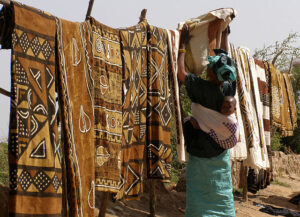
Bogolans seller at the ferry pier on the Bani river, Djenné, Mali, photo by BluesyPete, 26 November 2007, CCA-SA 3.0 Unported license
Export data from Mali shows that whether misrepresented as modern or not, the value of items exported does not come close to demonstrating either a unique or a dominant US market for Malian antiquities, antiques or ethnographic materials.
There are a great number of authenticated pre-1950s African artifacts, including from Mali circulating in both the U.S. and in Europe. (Pre-1950s objects are the only objects of serious interest to collectors.)
The international auction market captures much of the most valuable tribal and ethnographic artwork sold globally. The ARTKHADE 2021 Report is the tribal art industries’ closest equivalent to the ArtNet and Art Basel and UBS Global Art Market Report that provide global business analyses for the total art trade. (These other art business analyses do not even include antiquities and tribal art in their reporting, except as an “other” category including furniture and silver, all of whose total value of the art trade is less than one percent globally.)
The first paragraph of the ARTKHADE 2021 Report states that despite what were considered bumper sales in recent years, €58.5 million in 2019 and €76.3 million in 2018, the total annual sales of tribal art at global auction in 2020 was just €32.1 million.[22] Native American art from North America (Canada and the U.S. combined) was €3.3m of the total. By category, total global ethnographic auction sales in 2020 were measured as:
- African art €18.3million
- Oceanian art €5m
- South American €4.5m
- North American €3.3m
- Asian €856,520
The actual data on sales of African art, as collated by the primary analysts of market date on ethnographic art sales at auction worldwide show that Paris is as strong a market as New York. All of the high value items that sold had lengthy, documented provenances. African art is considered one of the art market sectors in which fakes and recent copies abound.
The Top Ten objects sold globally from Africa in 2020 were:
Between 84% and 96% of the tribal objects in every geographical category at global auction sold for less than €10,000. Less than 1% of any category sold for €50,000 or more, and only one category, African tribal sculpture had any sales larger than €500,000; less than one tenth of one percent (.09%) of objects were high value.[23]
(4) The Malian request or renewal of the thirty-year-old MOU does not meet the criteria that “the application of the import restrictions is consistent with the general interest of the international community in the interchange of cultural property.”
Historically the question of the general interest in the interchange of cultural property is dealt with by CPAC by counting the number of museum exhibitions and loans to the United States. While this kind of an answer actually does not address the question of how the “general interest of the international community” can or should be defined, it at least establishes a yardstick for relative public access.

Construction workers at work, Bamako, Rik Schuiling / TropCrop-TCS, July 20 2016, CCA-SA 4.0 International license.
CCP was unable to locate a single traveling exhibition from Mali to the U.S. during the last five years of the U.S.-Malian MOU. Some objects were loaned to the Smithsonian for an exhibition in recent years, and an exhibition of films featured craftsmen still working in mud masonry there. Mali’s government has failed to demonstrate that it has undertaken to make its cultural heritage available to the U.S. or the global public.
Mali has acted domestically in only one important matter internationally to preserve its heritage, bringing the case of Ahmad Al-Faqi Al-Mahdi to the International Criminal Court at The Hague (ICC) for destroying Mali’s cultural property. The ICC charged Al-Faqi Al-Mahdi with war crimes for the destruction of shrines of Sufi Saints in Timbuktu and the destruction of the sacred gate of the Sidi Yahia Mosque. ICC held that Ahmad Al-Faqi Al-Mahdi was guilty of war crimes and sentenced him to nine-years imprisonment.[24]
If hard evidence shows that there is both significant looting and a U.S. market for looted objects, the CPAC should recommend temporary emergency import restrictions only.

The Great Mosque of Djenne, World Heritage Site, photo by BluesyPete, 26 November 2007, CCA-SA 3.0 Unported license.
Under the conditions specified under the CPIA, the request from the Republic of Mali for a renewal of its bilateral agreement with the US cannot be undertaken. However, the Committee for Cultural Policy and Global Heritage Alliance believe that the protection of Malian heritage can most appropriately be addressed by adopting the recommendation made during the 2017 renewal process by the Association of Art Museum Directors that CPAC recommend temporary emergency import restrictions only. Temporary emergency import restriction could give Mali time to demonstrate its compliance with the four determinations – and if Mali fails to do so, then they should not be renewed.
We also urge CPAC to place strict benchmarks for extension to a bilateral agreement in the future. Given the restrictions in trade resulting from any agreement and the lack of past loan agreements, terms should be included that require Mali to make a defined commitment to make objects of cultural significance available for loan for U.S. museum exhibitions. Thus, U.S. citizens (including citizens of Malian heritage) will not be deprived of the opportunity to learn about and admire the contributions of Mali to the history of world culture.

Convicted of cultural property crimes, Ahmad al-Faqi al-Mahdi .
Mali should be required to demonstrate sincere efforts to provide domestic protection to its heritage and archaeological sites; to document its cultural objects so that if they are lost or stolen they may be readily identified, to curb corruption that allows objects to be exported to other nations as well as the U.S., to build relationships with U.S. museums and educational institutions to enable continuing research and study into Malian heritage both in Mali and in the U.S., and to benefit the American public, the Malian people, international scholars and visitors by enabling U.S. museums to give temporary safe harbor and exhibition space to Malian artifacts that its government wishes to secure and preserve.
Therefore, terms should be included under any emergency (or bilateral) agreement that must be met for any future continuation or extension, such as:
The Government of the Republic of Mali will facilitate the exchange of its archaeological and ethnological materials, by:
- Creating an online database or accessible list of objects of archaeological and artistic merit available for exhibition or long-term loans;
- Increasing the number of exhibition loans;
- Increasing the length of loans of objects of archaeological and artistic interest for research and educational purposes to a reasonable time period;
- Encouraging American museums and universities to propose and participate in joint excavation projects authorized by the Government of Mali and enabling a portion of excavated materials to be lent to educational institutions or U.S. museums for further study; and,
- Promoting agreements for academic exchanges and specific study programs agreed upon by museums and universities of Mali and American art museums.[25]
The US should encourage relationships between government and cultural institutions in Mali and the U.S. to enable safe harbor agreements.
It was a goal of the United States in the drafting of the CPIA to encourage both the United States and foreign governments to make US museums their temporary partners in preservation in times of crisis and to safeguard the source countries irreplaceable treasures in instances of conflict and violence.

Islamist fighters in northern Mali, photo Idrissa Fall, 26 July 2012, public domain (VOA).
Any agreement or emergency action on Mali’s cultural heritage should include an undertaking by the U.S. government, as the AAMD suggested in 2017, “at the request of the Government of Mali, to use its best efforts to become a safe haven for cultural heritage by assisting in finding depositories for objects that are subject to potential destruction, with a commitment to return those objects whenever the Government of Mali deems appropriate. One way to carry out this commitment would be for AAMD member museums to take the rescued objects on loan, pursuant to safe havens protocol already established by the AAMD.[26]” [27]
The Committee for Cultural Property and Global Heritage Alliance agreed with the AAMD in 2017 when it expressed serious reservations that Mali could meet the statutory criteria for an MOU due to the instability of the country and suggested that, with the approval of the Government of Mali, US museums could assist by providing temporary safe harbor, access to scholars, and public exhibition that would celebrate Mali’s brilliant historic heritage. The AAMD’s recommendation regarding safe harbor has equal merit today.[28]
Conclusion
The situation of the Malian people has worsened today through repeated political upheavals, chronically ineffectual local and national governance, massive corruption undermining the rule of law, repeated coup d’états in Bamako, the dominance of violent extremists and local militias in large areas of the country, and the destabilization of the Malian rural economy through massive land grabs by well-connected businessmen, all of which have not only endangered Mali’s cultural heritage in manifold ways, but also destroyed villages and habitat, impoverished farmers and driven herding communities to the brink of starvation.[29]

Flag of Mali, 5 April 2012, photo rgaudin, CCA-SA 3.0 Unported license
If import restrictions on Malian art and artifacts are to be continued, and can be justified under the facts, then the only lawful option is to enact emergency restrictions and to impose clear benchmarks for improvement of Mali’s domestic protections for its cultural heritage. CPAC should set clear conditions for any continuing import restrictions and insist that each requesting government be held accountable to its undertakings and that the Department of State should make public not only source country requests but also factual analyses of domestic threats to heritage in foreign countries and evaluation of foreign government actions. Numerous sections of the State Department make public such reports and analyses with respect to human rights, religious freedom and other matters essential to developing U.S. public policy. While these analyses are often highly critical of foreign governments, their publication does not result in weakening of U.S. security or breaches in foreign relations. U.S. policy would be better served by greater transparency at the Bureau of Educational and Cultural Affairs.
Key Safeguards for the US Public Interest
- The United States should require real standards for performance under an MOU or for renewal of an emergency action.
- Ask the Government of Mali and its National Directorate of Cultural Patrimony to guarantee loans will be made under term acceptable to both Mali and US museums.
- Encourage the Department of State to facilitate documentation of art and artifacts in Malian collections by means of grants and cooperative programs in order to prevent theft and encourage preservation.
Congress placed procedural and substantive constraints on the executive authority to impose import controls under the CPIA. Under the aegis of the State Department’s Bureau of Educational and Cultural Affairs, import restrictions under the CPIA have provided for near permanent bans on the import of virtually all cultural items from the prehistoric to the present time from the countries which have sought agreements. If CPAC fails to heed the concerns of Congress and ignores the CPIA’s four legal determinations, then CPAC will be both in derogation of law and acting against the best interests of the people of the United States.
[1] Danielle Paquette, Russian mercenaries have landed in West Africa, pushing Putin’s goals as Kremlin is increasingly isolated, Washington Post, March 9, 2022, https://www.washingtonpost.com/world/2022/03/09/mali-russia-wagner/
[2] Jared Thompson, Catrina Doxsee, and Joseph S. Bermudez,Tracking the Arrival of Russia’s Wagner Group in Mali, February 2, 2022, Center for Strategic & International Studies, https://www.csis.org/analysis/tracking-arrival-russias-wagner-group-mali.
[3] Id.
[4] The remainder of this article draws on the testimony submitted to the Cultural Property Advisory Committee (CPAC), Bureau of Educational and Cultural Affairs, U.S. Department of State, on the Proposal to Extend the Agreement Between the Government of the United States of America and the Government of the Republic of Mali Concerning the Imposition of Import Restrictions on Certain Categories of Archaeological Material and Ethnological Material of the Republic of Mali.
[5] Catherine Schofield Sezgin, How the Severe Problem of Looting of Archaeological Sites Was Exacerbated By Demand in the Art Market for Wooden and Ceramic Masks, http://art-crime.blogspot.com/2011/03/samuel-sidibe-director-of-national.html?utm_source=feedburner&utm_medium=feed&utm_campaign=Feed%3A+arcablog+%28ARCAblog%29 (last visited Mar. 17, 2022)
[6] Id.
[7] Id.
[8] Out of tens of thousands to 400 thousand manuscripts or manuscript pages in dozens of libraries (number vary hugely) it is estimated that 4,203 manuscripts from the Institute of Higher Islamic Studies and Research Ahmed Baba were burnt or stolen. See Dulcie Leimbach, Saving Timbuktu’s Manuscripts, One Ancient Page at a Time, One Pass, August 25, 2014, https://www.passblue.com/2014/08/25/saving-timbuktus-manuscripts-one-ancient-page-at-a-time/
[9] Tessa Solomon, Museum of Fine Arts Boston to Return Terra-cotta Figures from Mali in Latest Restitution Effort, ARTnews, February 9, 2022, https://www.artnews.com/art-news/news/mfa-boston-returns-objects-mali-1234618590/
[10] The Committee for Cultural Policy, Inc (CCP) is an educational and policy research organization that supports the preservation and public appreciation of the art of ancient and indigenous cultures. CCP supports policies that enable the lawful collection, exhibition, and global circulation of artworks and preserve artifacts and archaeological sites through funding for site protection. CCP deplores the destruction of archaeological sites and monuments and encourage policies enabling safe harbor in international museums for at-risk objects from countries in crisis. CCP defends uncensored academic research and urges funding for museum development around the world. CCP believes that communication through artistic exchange is beneficial for international understanding and that the protection and preservation of art is the responsibility and duty of all humankind. The Committee for Cultural Policy, POB 4881, Santa Fe, NM 87502. www.culturalpropertynews.org, [email protected].
[11] Global Heritage Alliance, Inc (GHA) advocates for policies that will restore balance in U.S. government policy in order to foster appreciation of ancient and indigenous cultures and the preservation of their artifacts for the education and enjoyment of the American public. GHA supports policies that facilitate lawful trade in cultural artifacts and promotes responsible collecting and stewardship of archaeological and ethnological objects. The Global Heritage Alliance, 5335 Wisconsin Ave., NW Ste 440, Washington, DC 20015. http://global-heritage.org/
[12] “Import Restrictions Imposed on Significant Archaeological Artifacts from Mali,” Emergency Actions and Designated List, Federal Register (Washington, D.C.: Department of the U.S. Treasury, Customs Service, September 23, 1993), https://eca.state.gov/files/bureau/ml1993eafrn.pdf. 1997: Agreement Between the Government of the United States of America and the Government of the Republic of Mali Concerning the Imposition of Import Restrictions on Archaeological Material from the Region of the Niger River Valley and the Bandiagara Escarpment (Cliff) (with Appendix),” Bilateral Agreement (Washington, D.C.: U.S. Department of State, Bureau of Education and Cultural Affairs, September 19, 1997), https://eca.state.gov/files/bureau/mali-tias_1997-2007.pdf. Department of the U.S. Treasury, Customs Service, “Import Restrictions Imposed on Archaeological Artifacts from Mali,” Designated List, Federal Register (Washington, D.C., September 23, 1997); 2002 – “Agreement Between the Government of the United States of America and the Government of the Republic of Mali Concerning the Imposition of Import Restrictions on Archaeological Material from the Region of the Niger River Valley and the Bandiagara Escarpment (Cliff),” Diplomatic Note (Washington, D.C.: U.S. Department of State, Bureau of Education and Cultural Affairs, September 11, 2002), http://eca.state.gov/files/bureau/mali-tias_1997-2007.pdf.
[13] “Agreement Between the Government of the United States of America and the Government of the Republic of Mali Concerning the Imposition of Import Restrictions on Archaeological Material from the Region of the Niger River Valley and the Bandiagara Escarpment (Cliff),” Diplomatic Note (Washington, D.C.: U.S. Department of State, Bureau of Education and Cultural Affairs, September 11, 2007), http://eca.state.gov/files/bureau/mali_tias_1997-2007.pdf. “Extension of Import Restrictions Imposed on Archaeological Material from Mali,” Extended Agreement and Revised Designated List, Federal Register (Washington, D.C.: Department of Homeland Security, U.S. Customs and Border Protection, September 19, 2007), https://eca.state.gov/files/bureau/ml2007dlfrn.pdf.
[14] “Agreement Between the Government of the United States of America and the Government of the Republic of Mali Concerning the Imposition of Import Restrictions on Archaeological Material from Mali from the Paleolithic Era (Stone Age) to Approximately the Mid-Eighteenth Century,” Diplomatic Note (Washington, D.C.: U.S. Department of State, Bureau of Education and Cultural Affairs, August 15, 2012), https://eca.state.gov/files/bureau/mali_tias_2012.pdf.
[15] “Agreement Between the Government of the United States of America and the Government of the Republic of Mali Extending and Amending the Agreement of September 19, 1997,” Diplomatic Note (Washington, D.C.: U.S. Department of State, Bureau of Education and Cultural Affairs, September 14, 2017), Extension of Import Restrictions Imposed on Archaeological and Ethnological Materials From the Republic of Mali, Federal Register (Washington, D.C.: Department of Homeland Security, U.S. Customs and Border Protection, September 19, 2017), https://www.govinfo.gov/content/pkg/FR-2017-09-19/pdf/2017-20056.pdf.
[16] As organizations whose boards include three past members of CPAC, none of whom ever received informational materials that would have placed national security or diplomatic relations at risk, or even privileged information on the location of archaeological sites not otherwise available, we believe there is no legitimate reason for denial of information on the scope of the request to the public.
[17] U.S. Embassy, Mali, U.S. and Mali Launch New Cultural Preservation Project to Inventory Mali’s Rich Cultural Heritage Sites, September 5, 2019, https://ml.usembassy.gov/u-s-and-mali-launch-new-cultural-preservation-project-toinventory-malis-rich-of-cultural-heritage-sties/
[18] Zachary Small, U.S. Returns Over 900 Confiscated Artifacts to Mali, NY Times, November 22, 2021, https://www.nytimes.com/2021/11/22/arts/design/us-mali-looted-antiquities-returned.html
[19] Alex Greenberger, US sends back more than 900 Stolen Artifacts to Mali, ArtNews, November 23, 2021, the artifacts sent back to Mali on Monday. Courtesy Homeland Security
[20] Mali Exports of works of art, collectors’ pieces and antiques to United States, https://tradingeconomics.com/mali/exports/united-states/works-art-collectors-pieces-antiques
[21] Mali Exports of works of art, collectors’ pieces and antiques to France, https://tradingeconomics.com/mali/exports/france/works-art-collectors-pieces-antiques
[22] ARTKHADE Report 2021- Art Analytics, Arts From Africa, Asia, Oceania and the Americas, 2, https://www.artkhade.com/api/publications/pdf/00365c5794c8/Artkhade-Art-Tribal-2021-en.pdf.
[23] Id. at 7.
[24] See Marlise Simons, “Prison Sentence Over Smashing of Shrines in Timbuktu: 9 Years,” New York Times, September 27, 2016, https://www.nytimes.com/2016/09/28/world/europe/ahmad-al-faqi-al-mahdi-timbuktu-mali.html.
[25] This list is adapted from the Statement of the Association of Art Museum Directors Concerning the Agreement Between the Government of the United States of America and the Government of the Republic of Mali Concerning the Imposition of Import Restrictions on Archaeological Material from Mali from the Paleolithic Era (Stone Age) to Approximately the Mid-Eighteenth Century, submitted March 21, 2017. Association of Art Museum Directors, https://aamd.org/sites/default/files/key-issue/FINAL%20CPAC%20statement%20-%20Mali.pdf
[26] Association of Art Museum Directors, AAMD Protocols for Safe Havens for Works of Cultural Significance from Countries in Crisis, https://aamd.org/document/aamd-protocols-for-safe-havens-for-works-of-cultural-significance-from-countries-in-crisis (last visited 01/17/22).
[27] Association of Art Museum Directors, Statement of the Association of Art Museum Directors Concerning the Agreement Between the Government of the United States of America and the Government of the Republic of Mali Concerning the Imposition of Import Restrictions on Archaeological Material from Mali from the Paleolithic Era (Stone Age) to Approximately the Mid-Eighteenth Century, submitted March 21, 2017, p 5. https://aamd.org/sites/default/files/key-issue/FINAL%20CPAC%20statement%20-%20Mali.pdf (last visited 01/17/22).
[28] Id.
[29] David Lemmi, Marco Simoncelli and Ugo Lucio Borga, Mali suffers a toxic mix of climate change, militancy and corporate looting, TRT World, https://www.trtworld.com/magazine/mali-suffers-a-toxic-mix-of-climate-change-militancy-and-corporate-looting-51182
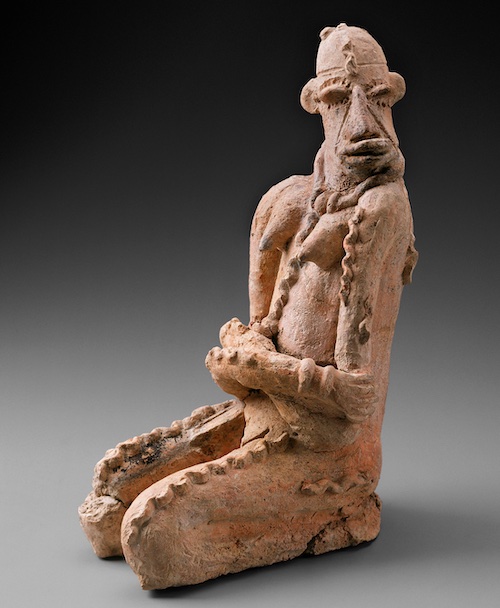 Djenne Terracotta Figure from the William Teel collection, to be returned to Mali by the Boston Museum of Fine Arts.
Djenne Terracotta Figure from the William Teel collection, to be returned to Mali by the Boston Museum of Fine Arts. 
